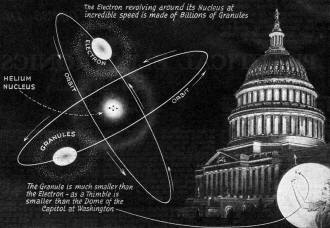The Enormous Electron
|
|
Anyone who pays attention in a present-day high school physics class would read this article from 1944 and immediately appreciate the advances that have been made in atomic theory during the ensuing 75 years. With modern knowledge, it is hard to believe that even in 1944 someone would seriously suggest that theorized sub-electronic particles (building blocks of electrons) might be responsible for supporting the propagation of electromagnetic energy. We still consider the electron to be an elementary particle (although now not so the proton and neutron), but at this point we are aware of many elementary particles other than the electron (some of which make up protons and neutrons). There are six types of quarks, the gluon, the photon, three types of bosons (including the newfound Higgs), and five other types of leptons other than the electron (the electron is a lepton) - for a total of 17. The author's characterizing of the electron as having a "flitting and jerking" "enormous" positional presence about the atomic nucleus rather than remaining in a simple and ordered "Earth-Moon" orbital relationship (the Bohr model), is amazingly akin to the modern quantum mechanical model. Thereby, an electron cloud orbital model asserts a vanishingly small probability that an electron associated with a given atom instantaneously occupies a point anywhere in the universe. The Enormous Electron Existence of sub-electronic particles has long been suspected, and their discovery may open another world to our atomic explorers. "There once was a tiny electron, who looked all about him and cried: 'What an infinite thing is an atom! How long and how deep and how wide'!" The science of physics, which successfully maintained the atom for so many years - against all opposition - as the world's smallest entity, was forced from its position, and today would not even insist that the electron is the infinite in smallness. Official science has been reduced to a position where an atom, comparatively speaking, may be as big as the State of Texas. More than ten years ago, Sir Joseph J. Thompson, the pioneer scientist who originally hunted the electron to its lair, declared his belief that space might be permeated with "granules" the substance of which make up the aggregates of matter and of electricity. These particles must be indeed small if, as Sir Joseph believed, they are at least 3,300,000,000 times smaller than the nimble electrons. The artist has pictured, above, the dome of the Capitol at Washington, and a thimble held up against it. The discrepancy in cubic contents is even less than one of three billion. The atoms of hydrogen, scientists now tell us, after viewing a few photographic scratches, are so small that a hundred million of them, if they ever became tired, could sit down side by side in a single inch. Yet each atom of hydrogen is supposed to be an Earth-Moon system, in which a tiny moon (the electron) is revolving millions of times a second around an almost invisible Earth - the nucleus, 1800 times as heavy as the electron, but smaller in bulk. However, the more the atom-electron theory was refined, the more unsatisfactory it became to explain, for instance, the peculiar actions of matter in presence of light. Instead of acting like a dignified moon, the electron is continually skipping around from orbit to orbit. It changes by fits and jerks. Evidently some other force, too small to be perceived by our instruments (which can just about see the shock of a violently propelled electron against the matter it strikes), is acting in infra-atomic space. If will be remembered that a similar agitation of small particles of matter, (the so-called Brownian movement) helped to establish the atomic theory of matter. This is one of the reasons why the father of the electron expressed as the conviction of years' study that, compared to the particles beneath them in size, electrons are gigantic. "We have no right whatever to maintain doggedly that we have reached the ultimate in infinitesimal material systems when we deal with. these familiar material units. Experience should quickly teach us how unsafe such an assumption would be," says Professor Harlow Shapley, the astronomer in Flights from Chaos. "But, in a hypothetical sub-electronic world, where there may be systems within systems indefinitely, our course-grained tools no longer bring information to our coarse-grained minds. It may be that we are stopped in our explorations downward, not because the limit is reached but because of our inherent awkwardness." Perhaps it is true that 'the "granule," so infinitesimally smaller than the atom, is itself a cosmic system of inconceivable complexity; as the entire "cosmos" we see may be a single breath exhaled by an extra-cosmic being. It is quite probable that the "granule" may be established as a fact, by reasoning; though far too small ever to manifest its individual presence upon any instrument which man can devise. It is not impossible to surmise, even though Sir Joseph is not quoted so far, that these granules may take the place of the hypothetical ether as the medium through which are translated electromagnetic impulses which we call light and its allied phenomena. If this be the case, and we are to assume that they act as does a gas, their motion is even swifter than that of light, set up by their "rarefaction" and "condensation."
Posted January 31, 2020 |
|

